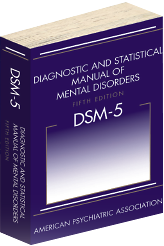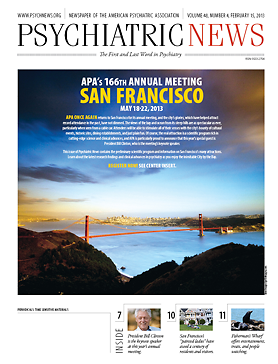The addition of two new diagnoses—disruptive mood dysregulation disorder (DMDD) and premenstrual dysphoric disorder (PMDD)—mark the major changes for the chapter on depressive disorders in DSM-5, which will be published in May.
Additionally, clinicians will find severity ratings for anxiety associated with depressive disorders, a new diagnosis to capture the concept of “chronicity,” and a “mixed features” specifier across the depressive disorders to identify depressed patients who have symptoms of mania. And the elimination of the so-called “grief exclusion” for major depression—which has garnered considerable media attention—means that patients experiencing severe and persistent depression related to bereavement can be diagnosed and treated.
(Removal of the exclusion eliminates the erroneous implication that grief ends after only two months, and a footnote in the text will provide explicit guidance on how to differentiate normal grief from a depressive disorder.)
Meanwhile, the chapter on anxiety disorders now includes separate diagnostic categories for agoraphobia and panic attack, acknowledging that many patients with agoraphobia do not experience panic. And separation anxiety disorder and selective mutism—previously classified as disorders of infancy, childhood, or adolescence—are now included in the anxiety disorders chapter.
A separate chapter for obsessive-compulsive and related disorders will appear, with four new disorders—hoarding disorder, excoriation (skin picking) disorder, substance- /medication-induced obsessive-compulsive and related disorder, and obsessive-compulsive and related disorder due to another medical condition.
The chapters on depressive, anxiety, and obsessive-compulsive disorders are the fourth, fifth, and sixth chapters of the new manual. The multiaxial system of previous editions has been eliminated, and chapters are now arranged according to a “lifespan” or developmental approach—disorders affecting children appearing first and those more common in older individuals appearing later.
Reconceptualizing Chronicity
In an interview with Psychiatric News, Jan Fawcett, M.D., chair of the Mood Disorders Work Group, said that the inclusion of disruptive mood dysregulation disorder is an effort to create criteria to identify children who experience extreme irritability without changes in mood that are characteristic of bipolar disorder and to address what some believe is an overdiagnosis of children with bipolar disorder.
“This came from the child and developmental group of researchers we worked with, and we accepted their recommendation to include these criteria in the hope that it will be an alternative to diagnosing bipolar disorder in a group of children who have persistent irritability and frequent episodes of extreme behavioral dyscontrol but who do not experience mania,” Fawcett said.
He added that brain-imaging work has revealed differences between children who have bipolar disorder and those who meet criteria for DMDD, for instance in amygdala reactivity to images of negative faces.
Fawcett said an enormous body of research supports moving PMDD from the “appendix” where it had appeared in DSM-IV, to a new diagnostic category in Section II of the new manual.
Also significant in the depressive disorders chapter is a reconceptualization of “chronicity.” What had been termed “dysthymia” in DSM-IV is now subsumed under “persistent depressive disorder,” which includes both chronic major depressive disorder and the previous dysthymic disorder. “We hope that this will focus research on a significant clinical reality—that chronicity is a significant factor in treatment outcome,” Fawcett said.
The elimination of the “grief exclusion” for major depression has attracted considerable attention from critics who say it medicalizes bereavement, a universal experience. But Fawcett reiterated that evidence has shown no difference in treatment response between grief- and non-grief-related depression. He added that depression frequently occurs in response to some kind of environmental stress or trigger.
Conceptually as important as any new diagnostic category is the addition of “mixed features” specifiers for patients with depression who have at least three symptoms of mania but who do not meet criteria for bipolar disorder and severity ratings for anxiety. Guidance for assessing suicide risk will also be provided.
Fawcett said these changes reflect an effort to move the depressive disorders away from a strictly categorical designation to a more dimensional approach in which depressive disorders can present with different degrees of severity and in the company of comorbid symptoms of anxiety or mania. “This is a first step toward seeing mood disorders as a spectrum with different degrees of severity rather than pure categories, which is an artificial way of slicing them up,” he said.
Obsessive-Compulsive Disorders Grouped
A major change that clinicians will notice is the creation of a separate chapter for obsessive-compulsive and related disorders, bringing together OCD, body dysmorphic disorder, and trichotillomania, which had been scattered in other areas of DSM-IV, and adding new diagnoses for hoarding disorder and excoriation (skin picking) disorder. (The chapter also adds new diagnostic categories for obsessive-compulsive disorders related to substance abuse or to a medical condition, reflecting an effort throughout the new manual to recognize symptoms attributable to substance abuse or other medical conditions).
In an interview with Psychiatric News, Katharine Phillips, M.D., chair of the Anxiety, Obsessive-Compulsive Spectrum, Posttraumatic, and Dissociative Disorders Work Group, said that the creation of a separate chapter for obsessive-compulsive disorders reflects evidence of the interrelatedness of these disorders in terms of diagnostic validators, as well as the clinical utility of grouping these disorders in the same chapter.
“The intention throughout DSM is to group together disorders that are similar to one another across a range of validators, including symptoms, neurobiological substrates, familiality, course of illness, and treatment response,” Phillips said. “These disorders have similarities in clinical features, such as driven, repetitive behaviors. Many tend to run in families, and some are comorbid. Our hope is that by bringing them together in one chapter, it will remind clinicians to look for a family history of the other disorders and comorbidity with other disorders when a patient presents with one of them.”
The addition of the distinct diagnoses of hoarding disorder and excoriation (skin picking) disorder grew out of research over the last several decades showing that they are both prevalent and clinically significant. Criteria for hoarding disorder include persistent difficulty discarding or parting with possessions, regardless of actual value, in a way that causes clinically significant distress or impairment in functioning. For example, a bedroom may be so cluttered with hoarded possessions that sleeping in the bed is impossible.
Phillips said that in the past, patients with hoarding disorder were liable to be diagnosed as having OCD, though most do not exhibit key features of OCD and may have a different response to treatment.
Key symptoms of excoriating (skin picking) disorder include persistent picking at skin resulting in lesions and sometimes infections and clinically significant distress. Phillips said the disorder has a prevalence of between 1 percent and 2 percent.
Finally, clinicians will note that all of the disorders with a cognitive component (OCD, hoarding disorder, and body dysmorphic disorder) have an “insight” specifier for rating patients’ insight into their disorder-related beliefs. For example, some patients with OCD may know that their house won’t burn down even though they feel compelled to check multiple times that the stove is off before leaving (“good or fair” insight); others may believe that the house probably will burn down (“poor” insight); and still others may be absolutely convinced that the house will burn down (“absent insight/delusional” beliefs).
“Clinical experience suggests that patients with delusional beliefs as a symptom of one of these disorders are sometimes diagnosed with a psychotic disorder, which may lead to inappropriate treatment with antipsychotic medication only,” Phillips told Psychiatric News. “The specifier will emphasize that patients with delusional beliefs that may occur as a symptom of these disorders do have OCD or body dysmorphic disorder or hoarding disorder. Those with OCD and body dysmorphic disorder should be treated with an SSRI rather than antipsychotic monotherapy.” ■
Additional information, including fact sheets on related topics and video interviews with David Kupfer, M.D., and Katharine Phillips, M.D., can be accessed at
http://www.psychiatry.org/dsm5. DSM-5 and related titles also may be pre-ordered from this site.

